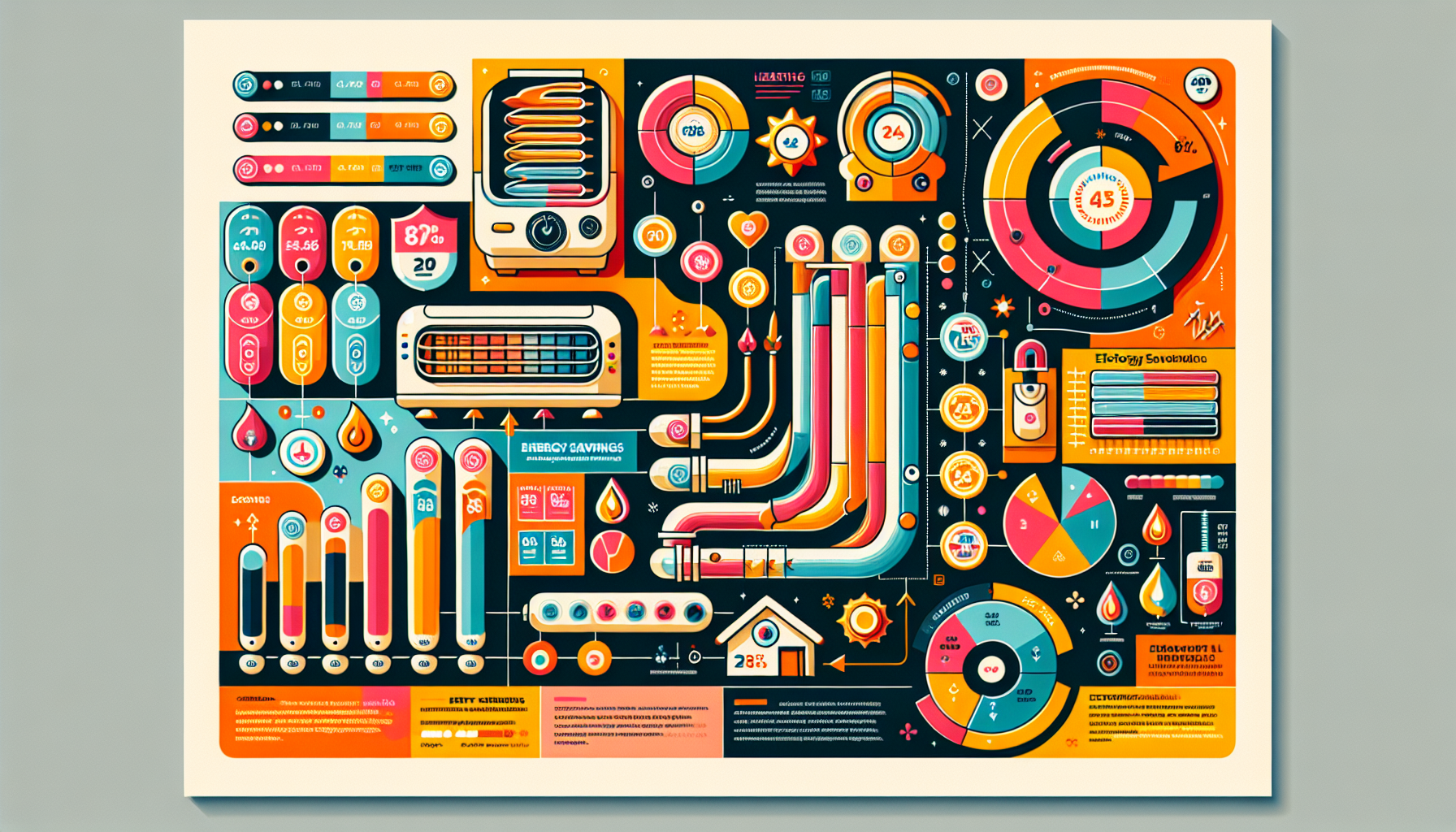Thinking about heating with electric? In this article, we’ll break down what electric heating systems are, explore their pros and cons, and guide you on choosing the best option for your home.
Key Takeaways
-
Electric heating systems provide a 100% efficiency rate as all consumed electricity is converted into heat, offering a sustainable alternative amid rising natural gas prices.
-
While electric heating systems have advantages such as environmental friendliness and ease of installation, they also face higher operational costs compared to gas heating options.
-
Various types of electric heating systems, including infrared panels, electric boilers, and heat pumps, cater to different home sizes and heating preferences, allowing for tailored solutions.
Understanding Electric Heating Systems

Electric heating systems utilize electricity to generate heat for space heating and hot water, boasting 100% efficiency as all consumed electricity is converted into heat. This technological marvel is becoming increasingly popular due to rising natural gas prices and a global shift towards low-carbon alternatives. With nearly universal access to the electricity grid, electric central heating systems are accessible to almost every household in the UK, promising a practical and sustainable solution.
The allure of electric heating systems extends beyond their environmental benefits. Innovations such as zero-emission boilers are revolutionizing the market, making the new electric heating system more effective and widespread than ever before.
We’ll explore what electric heating systems are, their advantages, and their disadvantages, to give you a comprehensive understanding of this modern heating solution.
What is an Electric Heating System?
An electric heating system is a solution that primarily relies on electricity. It generates both heat and hot water for various applications. These systems come in various forms, including electric boilers, electric radiators, infrared heaters, and storage heaters, each designed to meet different heating needs and preferences. Electric heating systems are incredibly versatile, capable of providing both air and water heating, making them suitable for a wide range of applications.
One of the standout features of electric heating systems is their remarkable efficiency. Unlike traditional gas boilers, electric heating systems convert nearly all the electricity they consume into heat, resulting in minimal energy wastage. Additionally, electric heating systems produce no CO2 emissions during operation, contributing to cleaner air and a healthier environment.
Moreover, electric heaters eliminate risks associated with burning fuel, such as carbon monoxide poisoning and explosions. This makes them a safer option for households. Common types of electric heating systems include storage heaters, which store heat during off-peak hours and release it during the day, and electric underfloor heating systems, which provide even heat distribution across a room.
Advantages of Electric Heating
Electric heating systems offer numerous advantages, making them an attractive option for modern households. One of the primary benefits is their environmental friendliness. Electric heating systems contribute to lower emissions compared to traditional gas heating solutions, significantly reducing the household carbon footprint. When paired with renewable energy sources like solar panels, the environmental impact is further minimized, making electric heating a sustainable choice.
Another advantage is the ease and speed of installation. Electric heating systems generally require less extensive infrastructure, resulting in simpler configurations and minimal disruption during installation. Furthermore, cost savings can be achieved with electric heating systems, especially when utilizing lower tariffs such as night-time rates. Advanced technologies like smart thermostats enhance cost efficiencies by optimizing energy usage, ensuring that electric heating remains a financially sensible choice in the long run.
Disadvantages of Electric Heating
Despite the numerous benefits, electric heating systems also come with certain disadvantages. One of the most significant drawbacks is the higher operational cost compared to gas heating. Electricity is generally more expensive per unit than gas, making electric heating financially burdensome for some households.
This aspect must be considered when evaluating the overall cost-effectiveness of switching to an electric heating system.
Types of Electric Heating Systems

Electric heating systems encompass a broad range of technologies, each designed to meet specific heating needs and preferences. From electric boilers and infrared panels to electric storage heaters and underfloor heating, the options are diverse and cater to various home sizes and configurations.
We’ll provide detailed insights into each type to help you understand their unique features and benefits.
Electric Boilers
Electric boilers are a popular choice for smaller homes, flats, and bungalows due to their compact size and minimal installation requirements. These boilers work by heating water using internal electrical elements, similar to how a kettle operates. The heated water is then circulated through radiators or underfloor heating systems, providing warmth throughout the home. Electric boilers can typically serve up to 15 radiators, making them suitable for modest-sized properties.
One of the key advantages of electric boilers is their ease of installation. Unlike gas boilers, they do not require flues or exhaust systems, reducing the need for extensive modifications to the home. This makes them an ideal choice for properties without access to a gas supply or those looking for a straightforward heating solution.
Additionally, their compact design allows for installation in smaller spaces, such as utility rooms or cupboards.
Infrared Panels
Infrared panels are an innovative heating solution that generates heat by converting electricity into infrared light, which directly heats people and objects in a room. This method of heating is similar to the warmth of sunlight but without the harmful UV rays. Infrared heating is more energy-efficient than traditional systems, as it reduces dust circulation and provides a healthier indoor environment.
The installation of infrared panels is versatile; they can be wall-mounted or ceiling-mounted, making them suitable for any room size and configuration. Standard infrared panels are available in various power outputs, typically up to 900W, and cost between £120 and £200 per panel. Their energy efficiency and health benefits make them an appealing choice for modern homes seeking both comfort and economy.
Electric Storage Heaters
Electric storage heaters operate by storing heat overnight and releasing it during the day, providing a consistent source of warmth. This mechanism takes advantage of cheaper night-time electricity tariffs, making them a cost-effective heating solution. Modern storage heaters have improved insulation and advanced features, such as integrated fans that help distribute heat more evenly throughout the room.
Selecting electric storage heaters requires considering the size of each room to determine the appropriate heater size. Once the stored heat is depleted, recharging the heaters requires proper planning to ensure continuous warmth.
However, modern models’ efficiency improvements make electric storage heaters a viable option for energy-conscious homeowners.
Electric Underfloor Heating
Electric underfloor heating systems can be categorized into two main types: electric heating cables and heating mats. These systems work by placing electrical wiring or heating mats beneath the floor, which then generate warmth that radiates upwards. This type of heating is particularly effective in bathrooms and smaller room renovations due to its space-saving design.
One of the significant advantages of electric underfloor heating is its relatively lower installation cost compared to wet underfloor heating systems, which require extensive plumbing work. Electric underfloor heating provides even heat distribution, ensuring a comfortable and cozy environment without the need for bulky radiators or heaters, making it an attractive option for modern homes.
Air Source Heat Pumps
Air source heat pumps operate by transferring heat from the outside air to the inside of a building, providing an efficient and sustainable heating solution. These systems generate heat by compressing vapor from a refrigerant fluid after passing air over an exchanger coil. Remarkably, air source heat pumps can operate in very low temperatures, down to -25 °C, ensuring reliable heating even in colder climates.
Air source heat pumps are particularly suitable for medium to larger homes, especially those with sufficient outdoor space for installation. They offer substantial heating capabilities, making them an excellent choice for properties seeking a low-carbon and energy-efficient heating solution.
Ground Source Heat Pumps
Ground source heat pumps utilize the relatively constant underground temperatures, typically between 8-15 °C, to provide efficient heating. These systems extract heat from below ground and transfer it indoors using a heat exchanger, offering a sustainable and cost-effective heating solution.
The installation of ground source heat pumps involves either vertical or horizontal pipe systems. Vertical installations require drilling a hole at least 6 meters deep for 50-150 meters of pipes, while horizontal systems involve laying pipes about 2 meters deep.
This efficient use of underground temperatures makes ground source heat pumps an excellent choice for homes with adequate outdoor space for installation.
Hybrid Heating Systems
Hybrid heating systems combine a traditional boiler with a renewable heating system, offering the best of both worlds. These systems can switch between renewable and traditional sources based on efficiency needs, optimizing energy use and reducing costs. For instance, a hybrid system might use a heat pump during milder weather and switch to a gas boiler during colder periods for maximum efficiency.
Hybrid heating systems are particularly suitable for larger homes with sufficient outdoor space to accommodate both traditional and renewable components. This flexibility in energy sources makes hybrid systems a versatile and efficient choice for modern households seeking to balance cost, efficiency, and environmental impact.
Choosing the Right Electric Heating System for Your Home
Selecting the right electric heating system for your home involves considering several factors such as home size, insulation levels, and specific heating needs. Properly estimating your home’s energy demands is crucial to maximize efficiency and manage costs.
We’ll provide tailored recommendations for small, medium, and large homes, along with special considerations for unique heating requirements.
Considerations for Small Homes
For smaller homes, compact and efficient heating solutions are key. Options like electric boilers and infrared panels are highly recommended due to their space-saving designs and effectiveness. Electric combi boilers, which combine heating and hot water in a single unit, are particularly suitable for small living spaces. Additionally, panel heaters can be an excellent choice, providing adequate warmth without occupying much space.
Electric storage heaters are another viable option for well-insulated small homes. These heaters store heat during off-peak hours and release it throughout the day, making them both economical and efficient. Utilizing cheaper night-time electricity rates can significantly reduce heating bills, ensuring a comfortable indoor temperature.
Options for Medium to Large Homes
Medium to large homes have different requirements that can be best met by systems like air source heat pumps and ground source heat pumps. Air source heat pumps require outdoor space for installation and can provide substantial heating even in colder climates. These systems are efficient and environmentally friendly, making them ideal for larger properties.
Ground source heat pumps are another excellent option for medium to large homes, especially those with sufficient outdoor space for pipe installation. Hybrid heating systems, which combine traditional and renewable energy sources, offer flexibility and efficiency, making them well-suited for larger homes with diverse heating needs.
Special Requirements
During renovations, underfloor electric heating can be particularly advantageous. This system is ideal for small spaces and provides a unique and efficient heating solution. Underfloor heating not only saves space but also offers even heat distribution, enhancing overall comfort.
Hybrid heating systems are another option to consider for homes with special requirements. These systems combine multiple sources of heat, optimizing energy efficiency and catering to diverse heating needs. By carefully considering unique heating requirements, homeowners can significantly improve their home’s comfort and efficiency.
Costs and Efficiency of Electric Heating Systems

Understanding the costs and efficiency of electric heating systems is crucial for making an informed decision. From installation to running costs, various factors influence the overall financial impact of these systems.
The following subsections will delve into the specifics of installation costs, running costs, and ways to maximize efficiency.
Installation Costs
The initial costs for electric heating systems can vary widely based on the model and features.
-
Budget options may start around £100
-
More advanced models can exceed £500
-
Ground source heat pumps, which are among the most expensive systems, can cost up to £21,000 for a 4-bedroom home
-
Air source and ground source heat pumps represent significant investments but offer long-term savings and efficiency.
Modern storage heaters typically cost around £400 each, while infrared panels and standard storage heaters range from £100 to £150 each. Installation costs for electric boilers are similar to those of gas boilers, providing a cost-effective alternative for households looking to switch to an electric heating system.
Running Costs
Running costs for electric heating systems are generally higher than for gas and oil heating, often costing more than double in a typical household. Electricity is roughly three times more expensive than gas per unit, making operating costs a key consideration for prospective users. However, utilizing time-of-use tariffs and night-time rates can help mitigate these costs, especially for homes with storage heaters.
Better insulation in electric storage heaters can further reduce energy bills by improving heat retention. For example, the monthly cost of running a 3kW electric storage heater for a 60m³ room is approximately £100, but this cost can be significantly reduced by using night-time tariffs.
Additionally, switching to more efficient options like heat pumps can help lower both running costs and emissions.
Maximizing Efficiency
Maximizing the efficiency of electric heating systems is essential for reducing running costs and environmental impact. Smart thermostats can learn user habits to create personalized heating schedules, optimizing energy usage and improving efficiency. Many smart thermostats also provide remote management capabilities, allowing users to adjust heating settings from anywhere via their smartphone.
Energy-saving features such as automatic window detection and night mode settings further enhance efficiency by adjusting heating based on environmental changes and reducing energy use during low occupancy hours.
Using individual thermostat controls on electric radiators can also improve energy efficiency by targeting heating only in occupied rooms. These advancements in technology make it easier than ever to maintain an energy-efficient and cost-effective heating system.
Maintenance and Longevity of Electric Heating Systems
Electric heating systems are known for their minimal maintenance requirements and long lifespan. With proper upkeep, these systems can provide reliable and efficient heating for many years.
The following subsections will detail the maintenance requirements and expected lifespan of various electric heating systems.
Maintenance Requirements
One of the significant advantages of electric heating systems is their negligible maintenance needs, making them convenient for homeowners. The average maintenance cost saving when using electric heaters compared to gas boilers is between £80 and £120 per year. Regular cleaning and occasional inspections are typically all that is required to keep these systems running smoothly.
Ground source heat pumps require maintenance checks every 3-5 years, while air source heat pumps need at least one professional maintenance check per year. Regular cleaning is also necessary to prevent dust accumulation, which can hinder performance and pose fire risks.
These simple maintenance tasks ensure the longevity and efficiency of electric heating systems.
Expected Lifespan
Electric heating systems are generally designed to outlast traditional gas heating systems, offering greater longevity. For instance, the lifespan of infrared heating panels can exceed that of other electric heating options, often lasting over 20 years. This durability makes electric heating systems a reliable and long-term investment for homeowners.
Environmental Impact of Electric Heating

Electric heating is increasingly viewed as a low-carbon alternative due to the integration of renewable energy sources into the electricity grid. These systems help reduce the carbon footprint of homes, especially when paired with renewable energy sources like solar panels.
The following subsections will discuss how electric heating systems contribute to reducing carbon footprints and the role of sustainable electricity sources.
Reducing Carbon Footprint
Electric heating systems produce no polluting gases or heavy metals, contributing to a cleaner environment. They emit significantly less harmful gases compared to gas heating, which helps lower overall carbon emissions. Using electricity generated from renewable sources further reduces a property’s carbon footprint, making electric heating an environmentally friendly choice.
The ecological benefits of electric heating systems can be maximized when they are paired with renewable energy sources, minimizing reliance on fossil fuels. This combination not only enhances energy efficiency but also promotes sustainable living practices, contributing to a greener future.
Sustainable Electricity Sources
Currently, renewables account for 40% of the UK’s power generation. Sustainable electricity sources are essential in minimizing the environmental impact of energy consumption. Choosing green electricity tariffs enables consumers to support energy generated from renewable resources, further reducing their carbon footprint.
Solar panel installations allow homeowners to generate their own sustainable electricity, reducing reliance on fossil fuels. This self-sufficiency not only reduces energy bills but also promotes a sustainable and eco-friendly lifestyle. Integrating renewable energy sources with electric heating systems allows homeowners to significantly contribute to environmental conservation.
Smart Features and Technological Advances in Electric Heating

Modern advancements in electric heating technology aim to enhance convenience and efficiency for users. From WiFi control and smart thermostats to integration with voice assistants, these technological features improve energy management and user experience in electric heating systems.
We’ll delve into these innovations in detail.
WiFi Control and Smart Thermostats
Many electric heating systems now include built-in WiFi, allowing for enhanced control and convenience. WiFi connectivity enables users to manage their heating systems from their smartphones, using applications like Rointe Connect. This remote management capability allows for precise control of heating schedules, optimizing energy usage and reducing costs.
Programming radiators and electric towel rails with a weekly programmable thermostat can help save on heating costs, potentially reducing annual heating bills by up to 30%. Additionally, smart thermostats can be integrated with voice assistants like Amazon Alexa, allowing users to adjust temperatures with simple voice commands.
These features make managing home heating more intuitive and efficient.
Integration with Voice Assistants
Integration with modern voice assistants, such as Amazon Alexa, enhances the control and convenience of electric heating systems. This hands-free operation allows homeowners to manage temperature settings and schedules through voice commands, simplifying their heating management.
The compatibility with voice assistants makes electric heating systems more user-friendly and accessible.
Energy-Saving Modes
Installing a smart thermostat can significantly enhance the efficiency of electric heating systems. Features like Night Mode can turn off the LCD screen, saving energy when the heater is not in use. The open window function allows the heater to detect open windows, automatically adjusting settings to optimize energy usage.
These energy-saving modes not only reduce running costs but also contribute to a more sustainable and eco-friendly heating solution. By incorporating these advanced features, homeowners can enjoy a comfortable indoor environment while minimizing their energy consumption and environmental impact.
Summary
Summarizing the key points discussed, electric heating systems offer an efficient, eco-friendly, and versatile alternative to traditional heating solutions. From compact electric boilers and infrared panels to robust ground source heat pumps and hybrid systems, the variety of options caters to different home sizes and heating needs. While the initial and running costs may be higher compared to gas heating, the long-term benefits in terms of efficiency, safety, and environmental impact make electric heating a worthy investment.
As we move towards a more sustainable future, embracing electric heating systems and integrating them with renewable energy sources can significantly reduce our carbon footprint and promote eco-friendly living. By leveraging smart technologies and energy-saving features, homeowners can optimize their heating systems for maximum efficiency and comfort. The future of home heating is electric, and it’s time to embrace the change for a greener and more sustainable world.
Frequently Asked Questions
What is an electric heating system?
An electric heating system is a method that utilizes electricity to produce heat and hot water, ensuring that all consumed electricity is converted into heat effectively. This approach provides reliable warmth for residential or commercial spaces.
What are the advantages of electric heating?
Electric heating systems offer environmental benefits, ease of installation, and potential cost savings through the use of smart technologies and lower energy tariffs. Therefore, they represent an efficient and sustainable heating option.
Are electric heating systems expensive to run?
Electric heating systems tend to be more expensive to run than gas systems, though implementing energy-efficient solutions and taking advantage of favourable tariffs can help manage these costs effectively.
How long do electric heating systems last?
Electric heating systems can last over 20 years, particularly types such as infrared panels, indicating their durability and longevity.
Can electric heating systems reduce my carbon footprint?
Yes, electric heating systems can reduce your carbon footprint, particularly when used in conjunction with renewable energy sources, leading to a significant decrease in carbon emissions.
